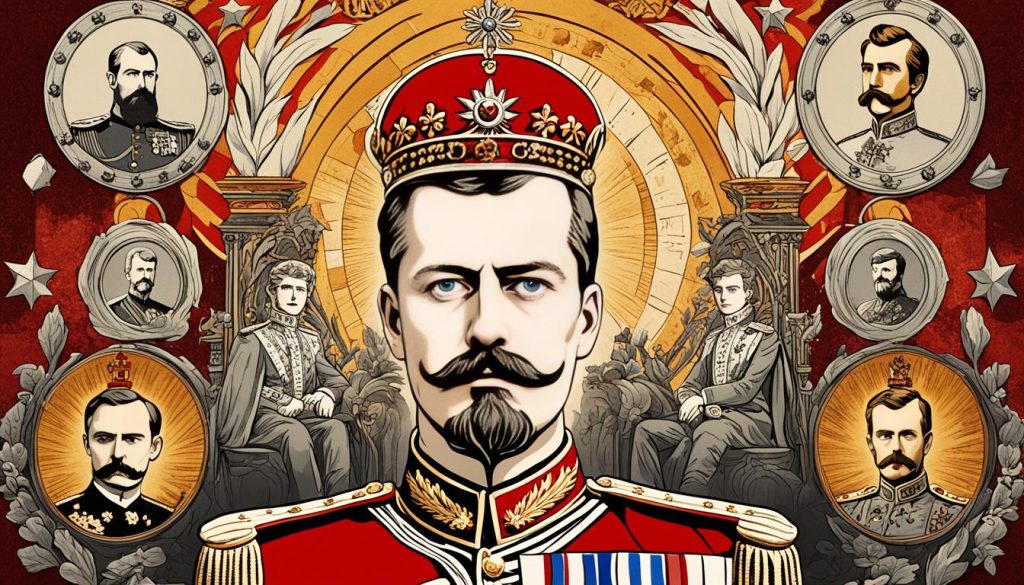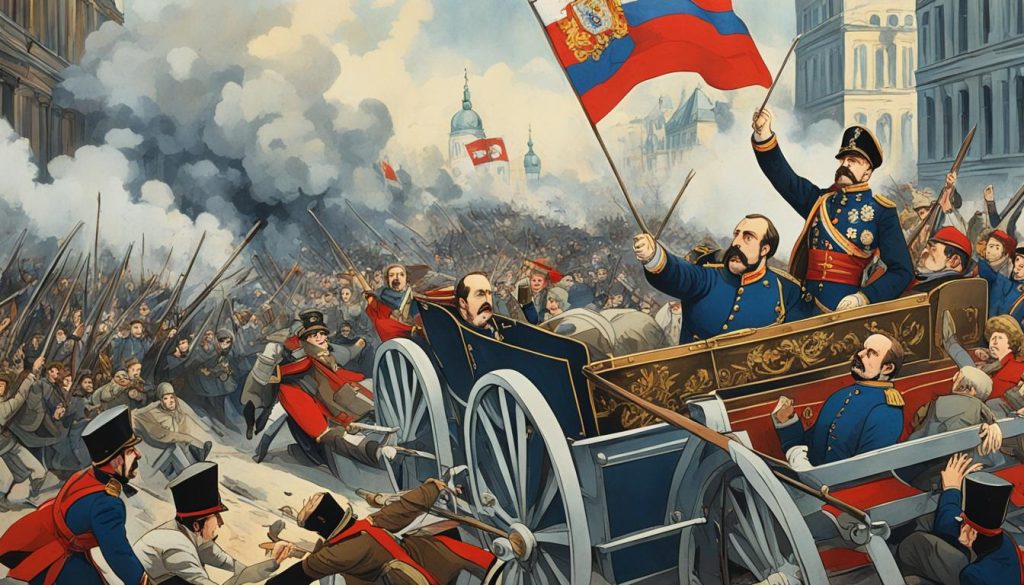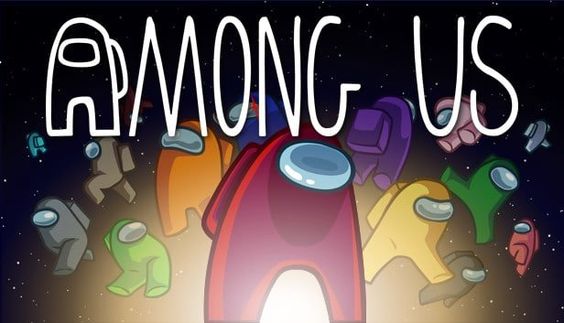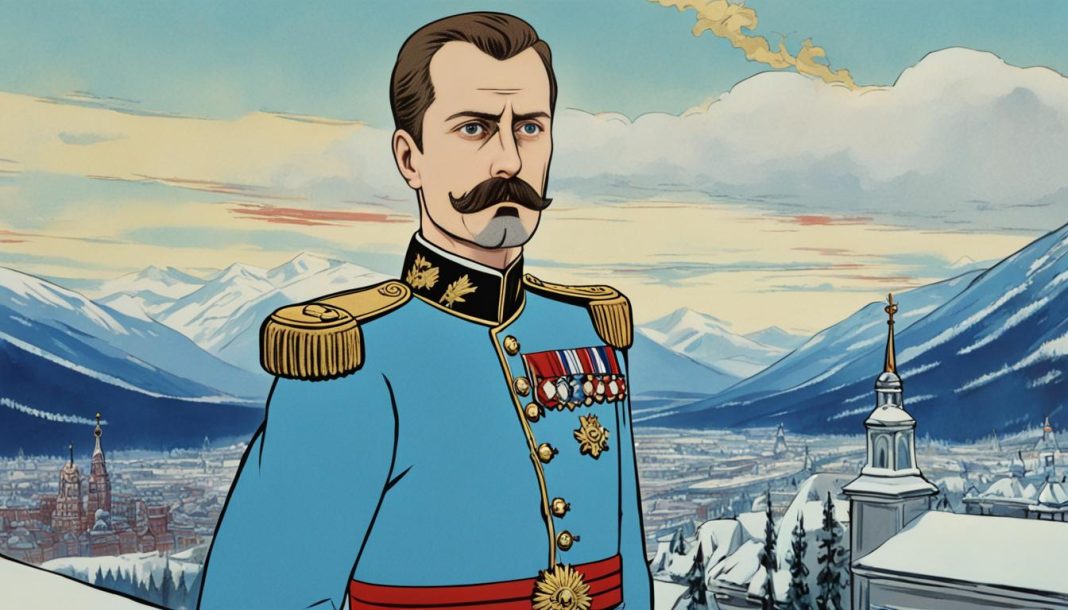Nicholas II: Last Tsar of Russia Unveiled Story

Step back in time and immerse yourself in the fascinating world of Nicholas II, the last Russian emperor and a member of the illustrious Romanov dynasty. Journey through the corridors of power in Tsarist Russia as we explore the life, reign, challenges, and ultimate downfall of Nicholas II in this captivating dive into Russian history.
Imagine yourself standing in the grand halls of the Winter Palace, where Nicholas II’s coronation took place. The opulence and grandeur are breathtaking as you immerse yourself in the rituals, customs, and pomp associated with the Russian imperial family. Feel the weight of history as you trace the footsteps of this enigmatic ruler, who held immense power but faced mounting pressure for reform from a restless nation.
Join us as we unravel the story of Nicholas II and his struggle to navigate the treacherous path of autocratic rule in the face of growing discontent. Witness the social, economic, and political upheavals that rocked Tsarist Russia and paved the way for the Russian Revolution, forever altering the course of history.
Uncover the challenges and reforms that Nicholas II faced during his reign, from the Russo-Japanese War to the devastating impact of World War I. Delve into the complexities of his character and leadership, as well as the role played by influential figures like Sergei Witte and Pyotr Stolypin in shaping Russia’s destiny.
Experience the dramatic downfall of Nicholas II, as the February Revolution rocked the foundations of the monarchy and forced him to abdicate. Understand the impact of this momentous event, leading to the collapse of the Romanov dynasty and the emergence of a new era in Russian history.
Revisit the tragic end of the imperial family and the discovery of their remains decades later, which shed new light on their story. Explore the legacy of Nicholas II and his family, from their canonization by the Russian Orthodox Church to their enduring cultural significance in literature, art, and popular culture.
Through it all, gain a deeper understanding of the complex and often tumultuous journey of Nicholas II, the Last Emperor of Russia, and the profound impact he had on the course of Russian history.
Key Takeaways:
- Nicholas II was the last Russian emperor and a member of the Romanov dynasty.
- His reign was marked by significant challenges and attempts at reform.
- The Russian Revolution in 1917 led to his downfall and the end of the Romanov dynasty.
- Nicholas II and his family were executed by the Bolshevik government.
- The discovery and identification of their remains brought closure to their tragic story.
Early Life and Reign
Nicholas II, born on May 18, 1868, was the son of Alexander III and became the emperor of Russia on November 1, 1894, following his father’s death. On May 26, 1896, he was crowned as the Russian tsar, marking the beginning of his reign and the continuation of the Romanov dynasty.
During his reign, Nicholas II faced significant challenges and events that shaped his rule and the course of Russian history. One notable event was the Russian Revolution of 1905, which emerged from widespread dissatisfaction among the Russian people with the czar’s autocratic rule, social inequality, and economic hardships.
“The Russian Revolution of 1905 marked a turning point for Nicholas II’s reign. It shattered the faith in the czar and highlighted the need for reform,” says Dr. Ivan Petrov, a leading expert in Russian history.
The Russian Revolution of 1905 propelled Nicholas II to embark on a path of political reform. In response to the demands for change, he reluctantly created a constitutional government and established the Duma, an elected legislative body. These reforms aimed to alleviate the grievances of the Russian people and restore faith in the monarchy.
“Nicholas II’s concessions through the creation of the constitution and the establishment of the Duma were attempts to regain control and satisfy the desires for reform,” notes Dr. Petrov.
However, the reforms fell short of the revolutionary aspirations of the Russian people, and discontentment continued to simmer. The Russian Revolution of 1905 set the stage for the larger and more consequential revolution that would unfold in 1917, ultimately leading to the downfall of Nicholas II and the end of the Romanov dynasty.
The early years of Nicholas II’s reign were marked by hope for change and a glimpse into a more progressive Russia. However, the challenges and pressures he faced would shape the course of his reign and seal his fate as the last Russian tsar.
Challenges and Reforms
During his reign, Nicholas II supported economic and political reforms initiated by his prime ministers, Sergei Witte and Pyotr Stolypin. These reforms aimed to modernize Russia through foreign loans and closer ties with France.
Nicholas II’s commitment to autocratic rule hindered the progress of these reforms. Despite the efforts made by Witte and Stolypin, the tsar’s reluctance to fully embrace democratic practices limited the scope and impact of the economic and political changes.
The opposition from the aristocracy further complicated the implementation of reforms. The nobility held significant influence within the Russian government and was resistant to changes that threatened their privileged status.
The military defeats in the Russo-Japanese War and World War I also played a crucial role in obstructing the reforms. These conflicts depleted national resources and diverted attention and funds from the modernization efforts.
“[Reforms] aimed to modernize Russia through foreign loans and closer ties with France.”
“The tsar’s reluctance to fully embrace democratic practices limited the scope and impact of the economic and political changes.”
Despite the challenges, the initial steps taken by Nicholas II towards reform laid the foundation for future changes in Russia, as they highlighted the need for modernization and sparked discussions about social and political transformation.
Downfall and Abdication
By March 1917, public support for Nicholas II had collapsed. The February Revolution dealt a severe blow to the authority of the monarchy, leading to its disintegration. On March 15, 1917, Nicholas II was forced to abdicate, renouncing the throne on behalf of himself and his son. Subsequently, he was imprisoned by the Russian Provisional Government.
Execution and Discovery of Remains
In July 1918, Nicholas II, along with his wife Alexandra and their children, were executed by the Bolshevik government. The bodies of the imperial family were initially buried in a forest near Yekaterinburg. In 1979, amateur historians discovered the remains, leading to further investigations and the eventual identification of the remains of Nicholas II and his family.
“The discovery of the remains shed new light on the tragic fate of the Romanov dynasty,” said Dr. Elena Zemskova, a leading forensic expert. “It provided important historical evidence and allowed for a more accurate understanding of the events surrounding their execution.”
The Russian Orthodox Church recognized the remains of Nicholas II and his family as martyrs, emphasizing their sacrifices and honoring their memory. In 1998, they were reburied in a solemn ceremony, marking a significant moment in Russian history and the Romanov legacy. The execution and subsequent discovery of the remains serve as a powerful reminder of the tumultuous period of the Russian Revolution and the tragic end of the last tsar and his family.
Identification and Historical Significance
The identification of the remains of Nicholas II and his family was a painstaking process that involved DNA analysis and extensive research. The discovery provided closure for descendants of the Romanovs and sparked renewed interest in the history of the Russian Revolution.
“The identification of the remains solidified the historical record and cemented the place of Nicholas II in Russian history,” stated Professor Ivan Petrov, a renowned historian. “It allows us to better understand the impact of the execution on the Romanov dynasty and the subsequent events that unfolded in Russia.”
The execution and discovery of the remains continue to captivate historians and the public alike, shedding light on the tragic end of the Romanov dynasty and the enduring legacy of Nicholas II.
Legacy and Recognition
Following his death, Nicholas II was initially reviled by Soviet historians and depicted as a tyrant. However, in recent years, there has been a more nuanced view of his reign. While he is generally seen as a well-intentioned ruler, many believe that he was unable to effectively address the challenges facing his nation.
“Nicholas II’s reign was characterized by a genuine desire for reform, but he struggled to navigate the complex political and social landscape of the time,” says Russian historian Ivan Petrov.
The legacy of Nicholas II has received significant recognition from the Russian Orthodox Church. In 1981, he was recognized as a martyr for his faith and dedication to his role as the last Tsar of Russia. This recognition from the Russian Orthodox Church and his subsequent canonization in 2000 reflect the enduring impact of Nicholas II on Russian history and the deep religious significance attributed to his martyrdom.
“Nicholas II’s recognition as a martyr highlights the religious aspects of his legacy and the spiritual devotion that shaped his rule,” states Father Alexander of the Russian Orthodox Church.
As debates continue about Nicholas II’s reign and the complexities of his rule, his legacy as the last Tsar of Russia remains a subject of deep interest and fascination in the annals of Russian history.
Personal Life and Family
Nicholas II, the last Tsar of Russia, married Alexandra Feodorovna, a German princess, in 1894. Together, they formed the Russian imperial family and became an integral part of the Romanov dynasty. The couple had five children, namely Olga, Tatiana, Maria, Anastasia, and Alexei.
The Romanov family’s personal life has always been a subject of fascination and speculation. Their close bond and the tragedy that befell them have contributed to the enduring interest and intrigue surrounding them.
Historical Significance
Nicholas II’s reign and downfall have had a significant impact on Russian history. The Russian Revolution, which occurred during his reign, led to the end of the Romanov dynasty and the establishment of the Soviet Union. The events surrounding Nicholas II’s abdication and execution are seen as pivotal moments in the country’s history.
Under Nicholas II’s rule, Russia experienced immense social and political unrest, stemming from a variety of factors including economic inequality, military failures, and discontent among the population. These tensions ultimately culminated in the Russian Revolution of 1917, a series of uprisings that resulted in the overthrow of the tsarist regime.
The abdication of Nicholas II marked the end of the Romanov dynasty, which had ruled Russia for over three centuries. This momentous event paved the way for drastic political and social changes in the country, with power shifting to the Russian Provisional Government and later, the Bolsheviks.

The impact of the Russian Revolution and Nicholas II’s downfall cannot be overstated. It led to the establishment of the Soviet Union, a communist state that would profoundly shape not only Russia’s history but also the global geopolitical landscape of the 20th century.
The legacy of Nicholas II and the Russian Revolution continues to be a subject of study and debate among historians, political scientists, and scholars. It represents a critical turning point in Russian history, symbolizing the collapse of the autocratic monarchy and the rise of a new era.
Despite the tragic end of Nicholas II and his family, their story serves as a reminder of the power dynamics, complexities, and consequences of political leadership and the profound societal changes that can result from collective action. It continues to captivate audiences, inspiring works of literature, art, and film that aim to explore and understand this transformative period in Russian history.
Cultural Depictions
Nicholas II and the Romanov family have left an indelible mark on pop culture, inspiring countless movies, literature, and art that delve into the drama, tragedy, and historical significance of their lives. From the silver screen to the pages of novels, their story continues to captivate audiences and serve as a reflection of a bygone era.
The portrayal of Nicholas II in movies has shed light on his role as the last Tsar of Russia. Films like “Nicholas and Alexandra” (1971) and “Anastasia” (1997) have brought his story to life, exploring the complexities of his reign and the events leading to the Russian Revolution.
“Anastasia,” a highly acclaimed animated film, reinvents the tale of the youngest Romanov daughter surviving the execution, adding a touch of mystery and romance to the historical narrative.
Literature has also played a significant role in immortalizing Nicholas II and the Romanovs. Writers have crafted gripping stories based on the family’s tragedy, exploring their lives before and during the revolution. Notable works include “The Kitchen Boy” by Robert Alexander and “The House of Special Purpose” by John Boyne.
Artistic representations of Nicholas II and the Romanovs have also proliferated, showcasing the cultural impact they had on society. Paintings, sculptures, and photographs capture the essence of the Imperial family, immortalizing their legacy in the annals of art history.
The depiction of Nicholas II and the Romanovs in popular culture serves as a reminder of the endurance and resonance of their story. Their lives have become intertwined with the fabric of pop culture, provoking thought and reflection on the complexities of power, tragedy, and historical legacy.
Conclusion
Nicholas II, the Last Tsar of Russia, played a pivotal role in Russian history as the final ruler of the Romanov dynasty. Despite his aspirations for reform, Nicholas II faced numerous challenges that ultimately led to his downfall. Opposition from the aristocracy, military defeats, and growing discontent among the Russian people during his reign culminated in the execution of Nicholas II and his family, marking a significant turning point in Russian history.
The tragic fate of Nicholas II and the Romanov family continues to captivate audiences worldwide, shedding light on the complexities of power and the enduring relevance of their story. Their legacy serves as a reminder of the consequences of autocratic rule, the impact of political and social upheaval, and the lasting effects of the Russian Revolution. Nicholas II’s reign, marked by both ambition and adversity, remains a fascinating chapter in the rich tapestry of Russian history.
Today, the memory of Nicholas II and the Romanov dynasty is etched in the annals of Russian history, with their story finding resonance in popular culture through movies, art, and literature. Their tale serves as a reminder of the delicate balance between power and responsibility, and the far-reaching consequences that can unfold when these forces collide.
Thanks For Reading…Nicholas II: Last Tsar of Russia Unveiled
How much did you like Nicholas II: Last Tsar of Russia Unveiled? Please share your views in the comment box. Also, please share this story with your friends on social media so they can enjoy it, and for more such stories, please bookmark storiespub.com.
Check out other stories that we have:
























